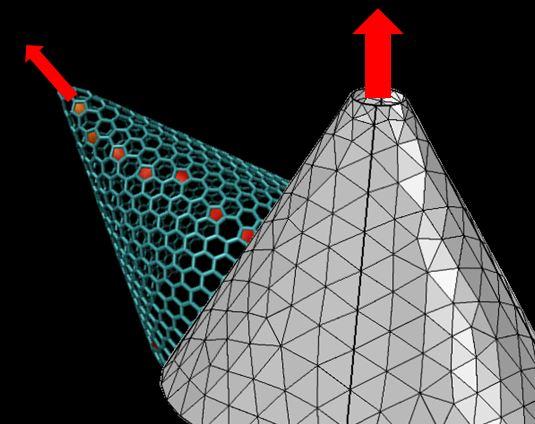Graphene flexes its electronic muscles

Researchers at Rice University and in Moscow used theoretical cones to show the unique electronic properties of flexed graphene. Credit: Yakobson Group/Rice University
Flexing graphene may be the most basic way to control its electrical properties, according to calculations by theoretical physicists at Rice University and in Russia.
The Rice lab of Boris Yakobson in collaboration with researchers in Moscow found the effect is pronounced and predictable in nanocones and should apply equally to other forms of graphene.
The researchers discovered it may be possible to access what they call an electronic flexoelectric effect in which the electronic properties of a sheet of graphene can be manipulated simply by twisting it a certain way.
The work will be of interest to those considering graphene elements in flexible touchscreens or memories that store bits by controlling electric dipole moments of carbon atoms, the researchers said.
Perfect graphene – an atom-thick sheet of carbon – is a conductor, as its atoms' electrical charges balance each other out across the plane. But curvature in graphene compresses the electron clouds of the bonds on the concave side and stretches them on the convex side, thus altering their electric dipole moments, the characteristic that controls how polarized atoms interact with external electric fields.
The researchers who published their results this month in the American Chemical Society's Journal of Physical Chemistry Letters discovered they could calculate the flexoelectric effect of graphene rolled into a cone of any size and length.
The researchers used density functional theory to compute dipole moments for individual atoms in a graphene lattice and then figure out their cumulative effect. They suggested their technique could be used to calculate the effect for graphene in other more complex shapes, like wrinkled sheets or distorted fullerenes, several of which they also analyzed.
“While the dipole moment is zero for flat graphene or cylindrical nanotubes, in between there is a family of cones, actually produced in laboratories, whose dipole moments are significant and scale linearly with cone length,” Yakobson said.
Carbon nanotubes, seamless cylinders of graphene, do not display a total dipole moment, he said. While not zero, the vector-induced moments cancel each other out.
That's not so with a cone, in which the balance of positive and negative charges differ from one atom to the next, due to slightly different stresses on the bonds as the diameter changes. The researchers noted atoms along the edge also contribute electrically, but analyzing two cones docked edge-to-edge allowed them to cancel out, simplifying the calculations.
Yakobson sees potential uses for the newly found characteristic. “One possibly far-reaching characteristic is in the voltage drop across a curved sheet,” he said. “It can permit one to locally vary the work function and to engineer the band-structure stacking in bilayers or multiple layers by their bending. It may also allow the creation of partitions and cavities with varying electrochemical potential, more 'acidic' or 'basic,' depending on the curvature in the 3-D carbon architecture.”
###
Co-authors are Alexander Kvashnin, a graduate student at the Moscow Institute of Physics and Technology and a researcher at the Technological Institute of Superhard and Novel Carbon Materials, and Pavel Sorokin, who has appointments at the Technological Institute of Superhard and Novel Carbon Materials and the National University of Science and Technology, Moscow. Both are former members of the Yakobson Group at Rice. Yakobson is Rice's Karl F. Hasselmann Professor of Materials Science and NanoEngineering, a professor of chemistry and a member of Rice's Richard E. Smalley Institute for Nanoscale Science and Technology.
The Russian Federation, Moscow State University, the Russian Academy of Sciences and the Air Force Office of Scientific Research's Multidisciplinary University Research Initiative supported the research. Work at Rice was supported by the Air Force Office of Scientific Research and the National Science Foundation.
Read the abstract at http://pubs.
This news release can be found online at http://news.
Follow Rice News and Media Relations via Twitter @RiceUNews
Related Materials:
Yakobson Research Group: http://biygroup.
Rice Department of Materials Science and NanoEngineering: http://msne.
Located on a 300-acre forested campus in Houston, Rice University is consistently ranked among the nation's top 20 universities by U.S. News & World Report. Rice has highly respected schools of Architecture, Business, Continuing Studies, Engineering, Humanities, Music, Natural Sciences and Social Sciences and is home to the Baker Institute for Public Policy. With 3,888 undergraduates and 2,610 graduate students, Rice's undergraduate student-to-faculty ratio is 6-to-1. Its residential college system builds close-knit communities and lifelong friendships, just one reason why Rice is ranked among some of the top schools for best quality of life by the Princeton Review and for best value among private universities by Kiplinger's Personal Finance.
Media Contact
All latest news from the category: Materials Sciences
Materials management deals with the research, development, manufacturing and processing of raw and industrial materials. Key aspects here are biological and medical issues, which play an increasingly important role in this field.
innovations-report offers in-depth articles related to the development and application of materials and the structure and properties of new materials.
Newest articles

NASA: Mystery of life’s handedness deepens
The mystery of why life uses molecules with specific orientations has deepened with a NASA-funded discovery that RNA — a key molecule thought to have potentially held the instructions for…

What are the effects of historic lithium mining on water quality?
Study reveals low levels of common contaminants but high levels of other elements in waters associated with an abandoned lithium mine. Lithium ore and mining waste from a historic lithium…

Quantum-inspired design boosts efficiency of heat-to-electricity conversion
Rice engineers take unconventional route to improving thermophotovoltaic systems. Researchers at Rice University have found a new way to improve a key element of thermophotovoltaic (TPV) systems, which convert heat…



